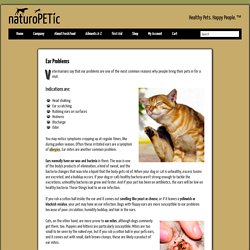

Valuable Nutrients for Seasonal Cat and Dog Allergies. Chronically Itchy or Smelly Dog? It Could Be Yeast Infections. By Dr.

Becker Most pet owners have heard the term yeast infection, but many don't know exactly what causes it. Sometimes a dog's family assumes their pet is just meant to have a bit of a stinky doggy smell, when in reality he has a problem with yeast overgrowth.Yeast is a spore-like type of fungi that reproduces through a process called budding. Budding just means that portions of the organism's cell body break off and form whole new yeast organisms.Yeast infections of the skin and ears are very common in dogs, and are caused by an organism called Malassezia pachydermatis.
A normal amount of yeast becomes an infection when the organism begins reproducing uncontrollably. Dogs Most at Risk for Yeast Infections Most dogs with yeast infections have immune system imbalances that inhibit the body's ability to control the yeast overgrowth. Symptoms and Signs of a Yeast Infection Diagnosing a Yeast Infection Treating Your Dog's Yeast Infection: Addressing the Diet Disinfecting Yeasty Feet.
How to Remove Skunk Smell from Dogs. Has your dog been sprayed by a skunk?

Even if you have never faced this problem, all dog owners should know how to handle it, just in case. You may have heard of skunk odor remedies like tomato juice or vinegar, but they really just cover up the odor. Products like Nature's Miracle Skunk Odor Remover have been known to work, but may be hard to find in a pinch. You can remove the odor from your dog using household items. It's all thanks to chemist Paul Krebaum, who developed the recipe in 1993. What To Do If Your Dog Was Sprayed By a Skunk Before attempting to remove the skunk odor, you must make sure your dog is not injured. My Healthy Animals. Veterinarians say that ear problems are one of the most common reasons why people bring their pets in for a visit.

Indications are: Head shakingEar scratchingRubbing ears on surfacesRednessDischargeOdor You may notice symptoms cropping up at regular times, like during pollen season. Often these irritated ears are a symptom of allergies. Ear mites are another common problem. Ears normally have ear wax and bacteria in them. If you rub a cotton ball inside the ear and it comes out smelling like yeast or cheese, or if it leaves a yellowish or blackish residue, your pet may have an ear infection. Cats, on the other hand, are more prone to ear mites, although dogs commonly get them, too. Most of the time, ear mites and mild ear infections are relatively easy to treat at home. Another ear problem which happens less frequently but is still worth mentioning is burrs in the ears. Herbal and Naturopathic Help First of all, you should give your pet a home checkup once a week. Cleaning ears. Balance IT® Fruits You Can Feed Your Dog. By Kristina Lotz and Melissa Kauffman | Posted: February 26, 2015, 4 p.m.

PST Humans love fruit and we know bananas and strawberries are good for us, but did you know they are good for your dogs too? Not only will your dog love that he is getting "human food,” but you will love that the same benefits fruits provide us – aids in digestion, antioxidants, immunity boosts, better eye sight, healthier skin and hair – they also provide for your dog. Feed fruits to your dog as a small training treat or stuff your dog’s favorite treat stuffer toy with some peanut butter and fruit for a great and healthy occupier.
Tips for Feeding Fruit to Dogs Always talk to your veterinarian about any treats you feed your dog, including fruit. Check out this list of 13 fruits (and melons) for dogs and their benefits to get you started. Apples: Source for potassium, fiber, phytonutrients, flavonoids, vitamin C. Bananas: Source of potassium and carbohydrates. (1 inch is a good size treat.) Fruit Bad for Dogs.